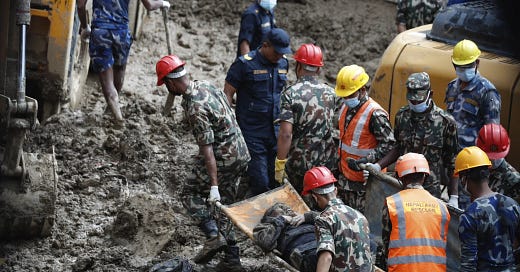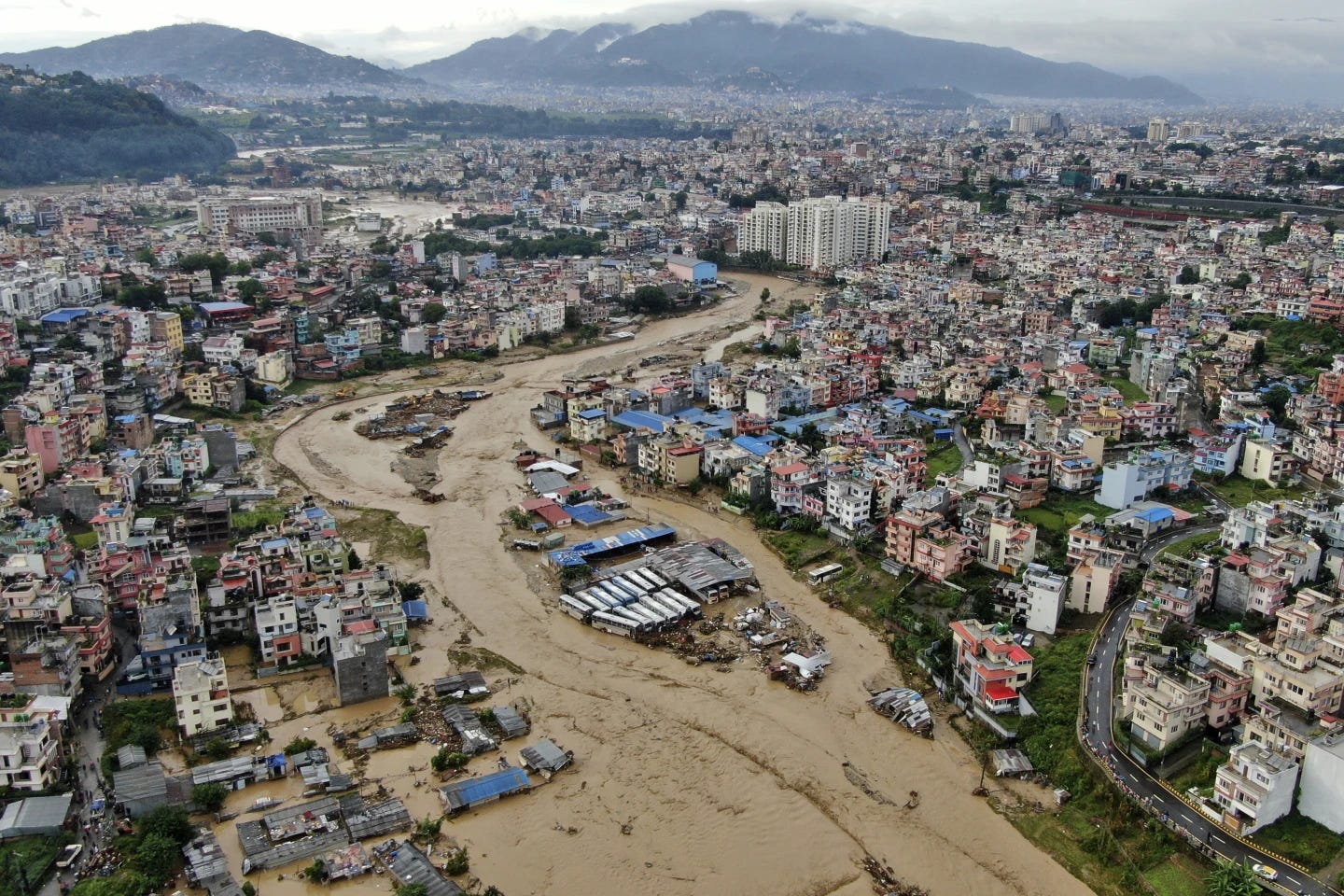193 Lives Lost in Catastrophic Rains, Floods, and Landslides in Nepal
Nepal, Bangladesh, and India: Navigating Natural Disasters and Developmental Challenges.
South Asia: Navigating Natural Disasters and Developmental Challenges
Introduction: A Region of Resilience and Vulnerability
Nepal and Bangladesh, two South Asian neighbours of India, share a geographical and historical closeness, but their natural landscapes make them vulnerable to frequent disasters like floods, landslides, and cyclones. These challenges, coupled with developmental pressures, greatly impact their socio-economic trajectories. Alongside these nations, India also finds itself grappling with the consequences of natural calamities. This article delves into how Nepal, Bangladesh, and India are addressing these issues and what measures are being taken to build more resilient societies.
Nepal: The Himalayan Nation at the Mercy of Nature
Devastating Floods and Landslides
Nepal, with its rugged mountainous terrain, faces frequent natural disasters such as floods and landslides, especially during the monsoon season. Recently, more than 193 people were killed in flooding and landslides, with dozens still missing. Major highways like the Prithvi Highway, a crucial route connecting Kathmandu to the rest of the country, were blocked by massive landslides, cutting off access to and from the capital. Thousands of residents were left stranded as rescue efforts struggled to clear the debris.
The disaster reveals the structural vulnerabilities of Nepal’s infrastructure and its ability to handle the consequences of increasingly severe monsoon seasons. The Nepalese government has responded by setting up temporary shelters and providing monetary aid to affected families, but the larger challenge lies in addressing the underlying risks that make such disasters so catastrophic.
Long-Term Recovery Plans
Nepal's experience underscores the need for long-term planning in disaster risk reduction, urban planning, and infrastructure development. Although rescue and recovery efforts, largely coordinated by the military and local authorities, have improved over the years, the Himalayan nation remains vulnerable due to its geography and limited resources. There is an urgent need for better early-warning systems, resilient infrastructure, and community-based disaster management strategies.
Bangladesh: Battling Floods on the Delta
Floods and the Low-Lying Geography
Bangladesh, characterised by its low-lying deltaic topography, is frequently inundated by floods, especially in its northern and coastal areas. Recently, about 60,000 people were affected by flooding due to the overflowing Teesta, Dharala, and Dudhkumar rivers. Entire villages in the northern regions of Bangladesh have been submerged, forcing residents to take shelter on roads and embankments, with limited access to food, clean water, and sanitation.
Proactive Measures in Bangladesh
In recent decades, Bangladesh has earned global recognition for its proactive disaster management strategies. The government has developed robust flood forecasting and early-warning systems, and constructed an extensive network of flood shelters. These measures have saved countless lives, but economic losses and displacement still remain significant. To further reduce the impact of these disasters, Bangladesh continues to strengthen its infrastructure and work with international partners to address climate change-induced risks.
The Wayanad Landslide Tragedy and Andhra Pradesh Floods in India
The Dual Disaster in Kerala and Andhra Pradesh
India, like its neighbours, is not immune to the ravages of natural disasters. The district of Wayanad in Kerala recently witnessed a tragic landslide, which claimed several lives and destroyed homes. The heavy monsoon rains triggered a series of mudslides, burying entire villages under tonnes of debris. Rescue teams, hindered by continuous rainfall and inaccessible terrain, worked tirelessly to save survivors, but the disaster exposed how fragile mountainous regions are to such natural calamities.
Simultaneously, the state of Andhra Pradesh has also been grappling with severe flooding caused by relentless monsoon rains. Hundreds of villages have been submerged, and thousands of people have been evacuated to temporary shelters. The swelling rivers of the state, such as the Godavari and Krishna, have breached their banks, inundating agricultural lands, homes, and infrastructure. In some regions, floodwaters have wiped out crops, devastating local economies dependent on farming.
Both the Wayanad landslide and the floods in Andhra Pradesh are stark reminders of how vulnerable India’s vast and varied landscapes are to the monsoon season. They also reveal gaps in preparedness and infrastructure, despite decades of policy efforts aimed at improving resilience to such natural disasters.
The Human Factor: Reckless Development and Environmental Degradation
While these disasters may seem like purely natural occurrences, the reality is that human activities have significantly contributed to their severity. In Kerala, the unregulated construction of roads, reckless mining, and deforestation have destabilised the hillsides, making them more susceptible to landslides. Similarly, in Andhra Pradesh, uncontrolled urbanisation and infrastructure development along riverbanks have disrupted natural drainage systems, exacerbating flooding. The cutting of mountains to build highways and railways, often without considering the environmental consequences, has weakened natural barriers, increasing the risk of landslides and floods.
These disasters underscore the need for a careful balance between development and environmental conservation. While infrastructure development is crucial for economic growth, it must not come at the cost of destabilising natural ecosystems that provide critical protections against such calamities.
Climate Change or Reckless Development?
While climate change has indeed exacerbated the frequency and intensity of natural disasters in South Asia, human activities like deforestation, mining, and unplanned urbanisation are significant contributors as well. In the fragile mountain regions of Nepal, Kerala, and northern Bangladesh, cutting into hillsides to build roads or mining for resources disturbs the natural equilibrium, making these areas prone to landslides. In flood-prone regions like Andhra Pradesh and Bangladesh, the destruction of wetlands and natural water drainage systems due to urban expansion has heightened the risk of severe flooding.
Towards a Resilient Future
As Nepal, Bangladesh, and India face these recurring challenges, the way forward lies in adopting more sustainable development practices. This includes enforcing stricter environmental regulations, creating disaster-resilient infrastructure, and ensuring early-warning systems are in place for vulnerable populations. Furthermore, international cooperation and community-driven approaches will play an essential role in addressing the long-term impacts of climate change and unregulated development.
India, in particular, must remain on constant vigil during the monsoon season. With its vast geographical diversity, the country needs tailored solutions for its mountainous, coastal, and riverine regions. Policies must focus not only on disaster response but also on prevention and sustainable development that does not compromise the environment.
Summing Up: A Shared Responsibility
Nepal, Bangladesh, and India, despite their distinct geographies, face common challenges when it comes to natural disasters. While climate change is a major driver of these calamities, human activities such as reckless urbanisation, deforestation, and infrastructure development have worsened the situation. Both the state and the public must work towards a more sustainable and disaster-resilient future.
As global climate patterns become increasingly unpredictable, it is essential for these nations to collaborate, share knowledge, and commit to safeguarding their populations. Only through coordinated disaster risk reduction, sustainable development, and the preservation of natural ecosystems can South Asia mitigate the devastating effects of natural calamities and protect future generations.






ਨਿਪਾਲ ਅਤੇ ਬੰਗਲਾਦੇਸ਼ ਤੋਂ ਇਲਾਵਾ ਭਾਰਤ ਦੇ ਕਈ ਸੂਬਿਆਂ, ਵੀਅਤਨਾਮ ਅਤੇ ਅਮਰੀਕਾ ਦੇ ਬਹੁਤ ਸਾਰੇ ਇਲਾਕਿਆਂ ਵਿੱਚ ਵੀ ਪਾਣੀ ਨੇ ਬਹੁਤ ਵੱਡਾ ਜਾਂਨੀ ਅਤੇ ਮਾਲੀ ਨੁਕਸਾਨ ਕੀਤਾ ਹੈ
ਕਹੁ ਨਾਨਕ ਕਰਤੇ ਕੀਆ ਬਾਤਾ ਜੋ ਕਿਛੁ ਕਰਣਾ ਸੁ ਕਰਿ ਰਹਿਆ
…….we continue to develop housing infrastructure without providing adequate passage for heavy flooding waters and the constrained passages erode the deep foundations of structures thereby causing havoc in cities. Natural surface runoff passages have to be maintained or where encroached, will have to be re-installed to save people……